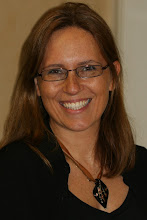Chapter 9 is written by Mary Kreul, a teacher with technology vision. The full title of the chapter is Connecting Technology and Literacy: A Journey from "How Do I Turn on This Computer?" to "My Class Is Blogging Their Book Reviews for Literature Circles."
I already know how to turn on the computer so I thought "Wow! I'm on my way to blogging with my students." This became a very important chapter for me.
I immediately related to Kreul's account of navigating the one computer classroom (she had to go to the library which is worse than I had to deal with). Yet her determination to overcome these obstacles made me feel a little guilty about my own gripes. I have one working computer in my room but at least it is connected to the Internet (high speed) and I can show my whole class what I am doing thanks to the T.V. monitor it is hooked up to. I also have a bank of 10 computers in the library but this does still make me mad as we can only book them for one 45 minute slot each week.
Although a major value of technology lies in the literacy skills children develop through reading and writing, I felt this chapter accentuated the value of technology in terms of communication. The ideas that Kreul shares most definitely hold their own in terms of literacy development but I want to focus this blog on the new literacies such as communicating via e-mail and telecollaborative projects. "The experience was valuable because it not only took students through the writing process but also demonstrated how a variety of technology skills come together n one project. After learning the technology skills necessary to create beautiful work in the form of a slide show, students were then able to use the Internet to share their work with others." (p144) As I stated in a previous post, children need to be equipped to be able to communicate through the technology of the day...who knows what it will be when our students are grown-up!
Keypal projects are touted as a beginning project, one that Kreul used before becoming more techno-savvy and ventured into telecollaborations. I went to ePals Classroom Exchange which I found on the Internet Keypal Exchange . Communication on this global scale is awe-inspiring. Jut a few years ago we had to write by snail mail. Today we can find out what is going on in classrooms all over the world. As I am from England, I decided to explore schools in Manchester where I grew up. I found my high school on ePals and will contact them to set up a project with their year seven students. I think it will be great for my students to discover school life in England and hear about what it was like for me at their age.
It was a relief for me when Kreul moved on to her experiences in fourth grade. I had been reading the chapter worrying about how to up the anti for my fifth graders. I too have used one or two techsperts to train my less advanced students. Using technology for book reports makes total sense to me. As adults we like to read reviews before we buy a book. Webpages with childrens' book reports, written in a similar style, give global access to children wanting to find out about a book they are possibly interested in.
Using blogs for students to post their responses to literature seemed to be a challenging task before I read this chapter. Then it all clicked into place. I just have to do what I am doing here...blog. I would like to do other things with my class blog such as add student work and timelines similar to Kreul. It will also open up the students' work to the whole world...their parents will also have instant access to their child's work and will observe the progress being made.
Image from: http://www.nova.edu/~kolemary/image002.gif
The Intrepid
16 years ago

No comments:
Post a Comment